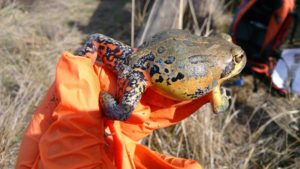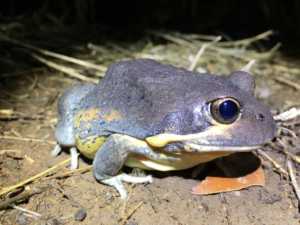
On a wet summers evening a large toad-looking creature was spotted in the backyard. With an upright posture and dark colouring, we were sure it was a cane toad. Just as it was about to meet the fate of all other pest cane toads in our backyard, we happened to notice some rather bright red markings this particular amphibian. This was no cane toad, but a Scarlet-sided Pobblebonk Limnodynastes terraereginae.
The Scarlet-sided Pobblebonk’s unusual name often causes slight confusion. This uniquely named individual is not a mythical creature, rather a local amphibian that resides in eastern Queensland and northern New South Wales. The Pobblebonk is also known as the Northern Banjo frog. Its name originates from its call that closely reflects a loud ‘bonk’ of a banjo string.
Large choruses of the Pobblebonk can be heard several kilometres away! Males use this call from October to May during their breeding season. The eggs are laid in a white foam nest on the water surface, resulting in dark brown tadpoles.
This species of amphibian prefers river flats, grassy open forests and woodlands. They usually reside near dams, swamps and other areas of static water with sufficient vegetation cover. The Pobblebonk is a reasonably large and robust frog, growing up to 75mm in size. They are part of Australia’s burrowing frogs, usually spending time underground during dry periods.
They have a large variation in colour and pattern between each individual frog. Their back is very dark brown or black, usually with a faint stripe. They have a whitish yellow belly with a yellow and scarlet colouring on their upper arm, and a defining red in the groin and along the thigh area. A pale yellow gland runs from just below the eye to the base of the arm. The Pobblebonk has no webbing on its fingers and very little webbing on the toes.
The Pobblebonk is part of a group collectively known as the “dorsalis complex” because of their similarities in shape, breeding biology and call structure. Its call is higher in pitch than others in the “dorsalis complex” group. Some Pobblebonk’s don’t have such a lucky outcome as the one in our backyard. Its similar features can often cause it to be unfortunately mistaken for a cane toad. Be sure to look out for any distinctive scarlet colouring or yellow stripe below their eye if you see a frog in your backyard. Perhaps you might even hear the Pobblebonk’s familiar ‘bonk’ call out on one of BOOBOOK’s tours!
For more info on distinguishing between native frogs, and cane toads, see this post.


